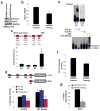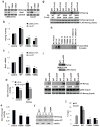Phosphorylation of Nanog is essential to regulate Bmi1 and promote tumorigenesis
- PMID: 23708658
- PMCID: PMC3912208
- DOI: 10.1038/onc.2013.173
Phosphorylation of Nanog is essential to regulate Bmi1 and promote tumorigenesis
Abstract
Emerging evidence indicates that Nanog is intimately involved in tumorigenesis, in part, through regulation of the cancer-initiating cell (CIC) population. However, the regulation and role of Nanog in tumorigenesis are still poorly understood. In this study, human Nanog was identified to be phosphorylated by human protein kinase Cɛ at multiple residues, including T200 and T280. Our work indicated that phosphorylation at T200 and T280 modulates Nanog function through several regulatory mechanisms. Results with phosphorylation-insensitive and phosphorylation-mimetic mutant Nanog revealed that phosphorylation at T200 and T280 enhance Nanog protein stability. Moreover, phosphorylation-insensitive T200A and T280A mutant Nanog had a dominant-negative function to inhibit endogenous Nanog transcriptional activity. Inactivation of Nanog was due to impaired homodimerization, DNA binding, promoter occupancy and p300, a transcriptional co-activator, recruitment resulting in a defect in target gene-promoter activation. Ectopic expression of phosphorylation-insensitive T200A or T280A mutant Nanog reduced cell proliferation, colony formation, invasion, migration and the CIC population in head and neck squamous cell carcinoma (HNSCC) cells. The in vivo cancer-initiating ability was severely compromised in HNSCC cells expressing phosphorylation-insensitive T200A or T280A mutant Nanog; 87.5% (14/16), 12.5% (1/8), and 0% (0/8) for control, T200A, and T280A, respectively. Nanog occupied the Bmi1 promoter to directly transactivate and regulate Bmi1. Genetic ablation and rescue experiments demonstrated that Bmi1 is a critical downstream signaling node for the pleiotropic, pro-oncogenic effects of Nanog. Taken together, our study revealed, for the first time, that post-translational phosphorylation of Nanog is essential to regulate Bmi1 and promote tumorigenesis.
Conflict of interest statement
The authors declare no conflict of interest.
Figures







Similar articles
-
Emerging role of nanog in tumorigenesis and cancer stem cells.Int J Cancer. 2014 Dec 15;135(12):2741-8. doi: 10.1002/ijc.28690. Epub 2014 Jan 13. Int J Cancer. 2014. PMID: 24375318 Free PMC article. Review.
-
Bmi1 regulates self-renewal and epithelial to mesenchymal transition in breast cancer cells through Nanog.BMC Cancer. 2014 Oct 28;14:785. doi: 10.1186/1471-2407-14-785. BMC Cancer. 2014. PMID: 25348805 Free PMC article.
-
CK2 phosphorylates and inhibits TAp73 tumor suppressor function to promote expression of cancer stem cell genes and phenotype in head and neck cancer.Neoplasia. 2014 Oct 23;16(10):789-800. doi: 10.1016/j.neo.2014.08.014. eCollection 2014 Oct. Neoplasia. 2014. PMID: 25379016 Free PMC article.
-
Attenuation of cancer-initiating cells stemness properties by abrogating S100A4 calcium binding ability in head and neck cancers.Oncotarget. 2016 Nov 29;7(48):78946-78957. doi: 10.18632/oncotarget.12935. Oncotarget. 2016. PMID: 27793047 Free PMC article.
-
BMI1 in the heart: Novel functions beyond tumorigenesis.EBioMedicine. 2021 Jan;63:103193. doi: 10.1016/j.ebiom.2020.103193. Epub 2021 Jan 6. EBioMedicine. 2021. PMID: 33421944 Free PMC article. Review.
Cited by
-
The Developmental Origins of Cancer: A Review of the Genes Expressed in Embryonic Cells with Implications for Tumorigenesis.Genes (Basel). 2023 Feb 28;14(3):604. doi: 10.3390/genes14030604. Genes (Basel). 2023. PMID: 36980876 Free PMC article. Review.
-
BMI1: A Biomarker of Hematologic Malignancies.Biomark Cancer. 2016 May 5;8:65-75. doi: 10.4137/BIC.S33376. eCollection 2016. Biomark Cancer. 2016. PMID: 27168727 Free PMC article. Review.
-
CITED2 and the modulation of the hypoxic response in cancer.World J Clin Oncol. 2020 May 24;11(5):260-274. doi: 10.5306/wjco.v11.i5.260. World J Clin Oncol. 2020. PMID: 32728529 Free PMC article. Review.
-
Emerging role of nanog in tumorigenesis and cancer stem cells.Int J Cancer. 2014 Dec 15;135(12):2741-8. doi: 10.1002/ijc.28690. Epub 2014 Jan 13. Int J Cancer. 2014. PMID: 24375318 Free PMC article. Review.
-
Aberrant expression of WWOX and its association with cancer stem cell biomarker expression.Int J Clin Exp Pathol. 2020 May 1;13(5):1176-1184. eCollection 2020. Int J Clin Exp Pathol. 2020. PMID: 32509092 Free PMC article.
References
-
- Niwa H, Miyazaki J, Smith AG. Quantitative expression of Oct-3/4 defines differentiation, dedifferentiation or self-renewal of ES cells. Nat Genet. 2000 Apr;24(4):372–6. - PubMed
-
- Mitsui K, Tokuzawa Y, Itoh H, Segawa K, Murakami M, Takahashi K, et al. The homeoprotein Nanog is required for maintenance of pluripotency in mouse epiblast and ES cells. Cell. 2003 May 30;113(5):631–42. - PubMed
-
- Masui S, Nakatake Y, Toyooka Y, Shimosato D, Yagi R, Takahashi K, et al. Pluripotency governed by Sox2 via regulation of Oct3/4 expression in mouse embryonic stem cells. Nat Cell Biol. 2007 Jun;9(6):625–35. - PubMed
-
- Torres J, Watt FM. Nanog maintains pluripotency of mouse embryonic stem cells by inhibiting NFkappaB and cooperating with Stat3. Nat Cell Biol. 2008 Feb;10(2):194–201. - PubMed
Publication types
MeSH terms
Substances
Grants and funding
LinkOut - more resources
Full Text Sources
Other Literature Sources
Molecular Biology Databases
Research Materials
Miscellaneous

